Coupling Intensive Land Use and Landscape Ecological Security for Urban Sustainability: An Integrated Socioeconomic Data and Spatial Metrics Analysis in Hangzhou City
Abstract
:1. Introduction
2. Materials and Methods
2.1. Study Area
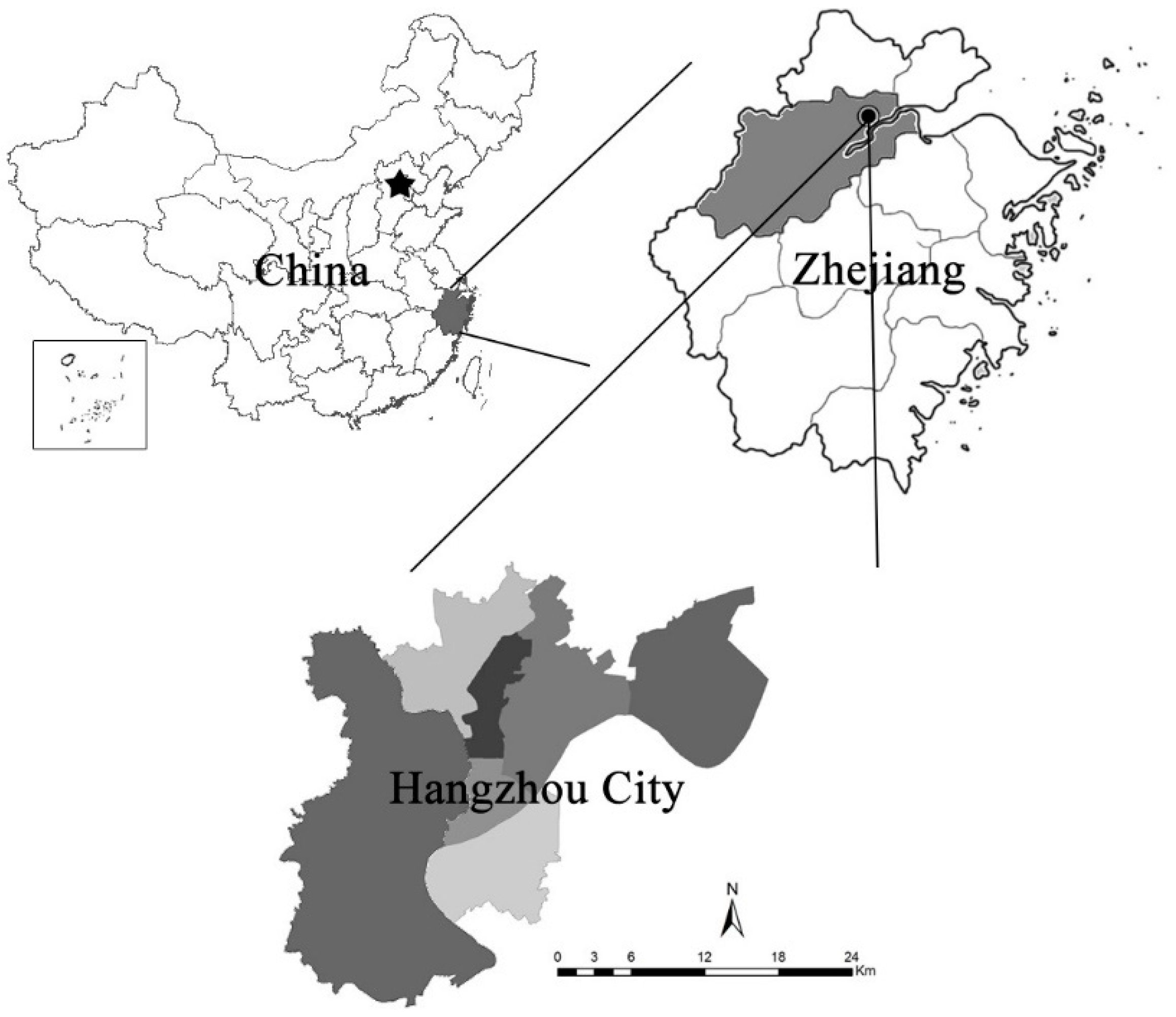
2.2. Data Sources and Pre-Processing
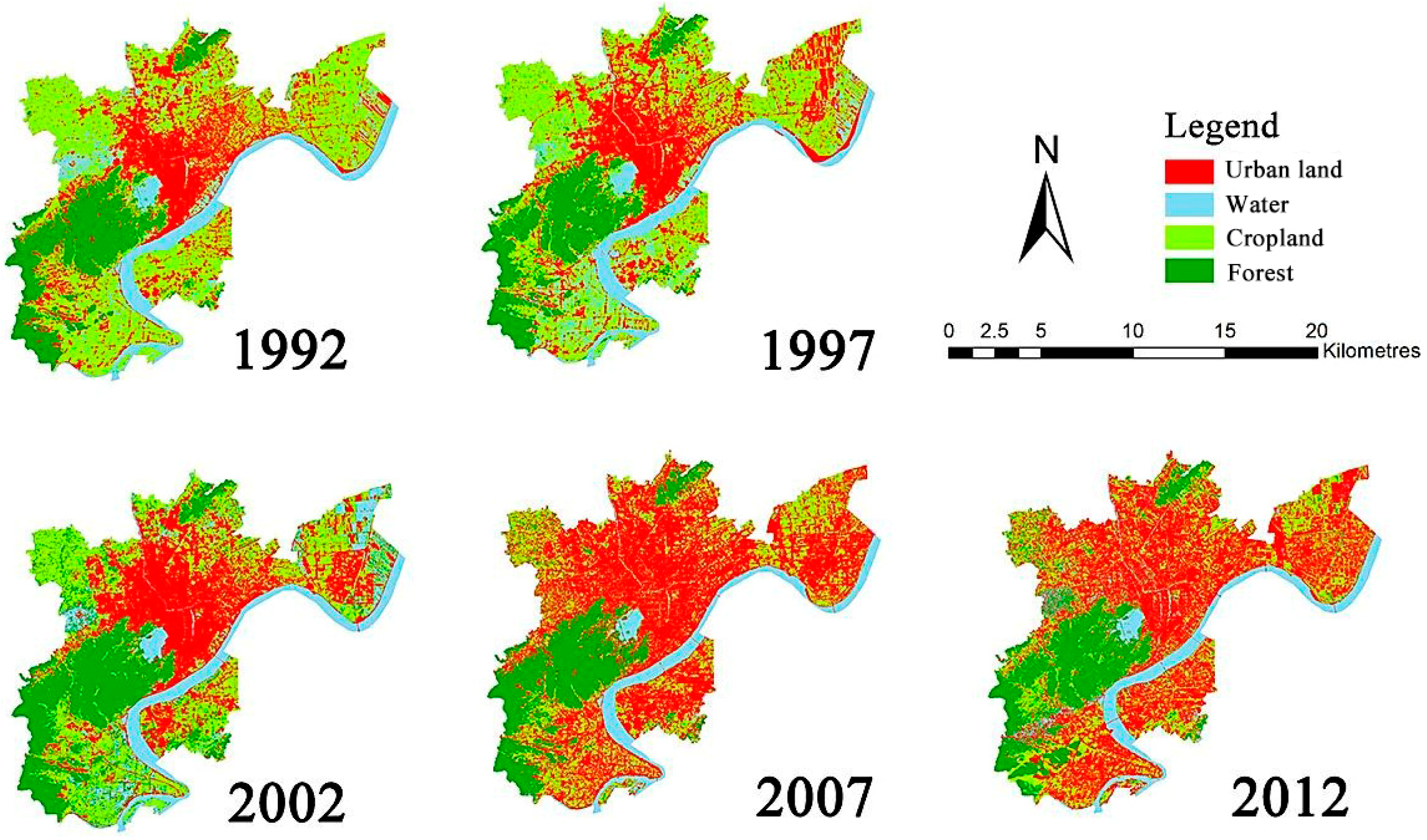
2.3. Model Description and Methodology
2.3.1. Evaluation Systems for ILU and LES
2.3.1.1. Development of the Evaluation System
| Objective Level | Criterion Level | Indicator Level | Unit | Description |
|---|---|---|---|---|
| ILU System f (L) (1.00) | Pressure (0.09) | X1: Population density (0.02) | p/km2 | Effects of human activities on urban land use. |
| X2: Urban land expansion elasticity (0.07) | N/A | |||
| State (0.70) | X3: Built-up area per person (0.12) | p/m2 | The physical and economic intensity of land use | |
| X4: Structure area per person (0.15) | p/m2 | |||
| X5: Fiscal revenue per square meter (0.03) | Yuan/m2 | |||
| X6: Output value of secondary and tertiary industry per square meter (0.40) | Yuan/m2 | |||
| Response (0.21) | X7: Investment in fixed assets per square meter (0.19) | Yuan/m2 | Human-induced response to intensive land use | |
| X8: Employees per square meter (0.02) | p/m2 |
| Cropland | Forest | Water | Urban land | |
|---|---|---|---|---|
| Gas regulation | 885.0 | 3097.0 | 0 | 0 |
| Climate regulation | 1575.2 | 2389.1 | 407 | 0 |
| Water reservation | 1062.1 | 2831.5 | 18,033.2 | 0 |
| Soil formation and protection | 2584.0 | 3450.9 | 8.8 | 0 |
| Waste treatment | 2902.7 | 1159.2 | 16,086.6 | 0 |
| Biodiversity conservation | 1256.4 | 2884.6 | 2203.3 | 0 |
| Food production | 1770.0 | 88.5 | 88.5 | 0 |
| Raw materials | 177.2 | 2300.6 | 8.8 | 0 |
| Recreation and culture | 18.6 | 1132.6 | 3840.2 | 0 |
| Total | 12,231.2 | 19,334 | 40,676.4 | 0 |
2.3.1.2. Multi-Criteria Evaluation
| Objective Level | Criterion Level | Indicator Level | Unit | Description |
|---|---|---|---|---|
| LES system f(E) (1.00) | Pressure (0.20) | Y1: City development intensity (0.20) | N/A | Effects on landscape in urban areas |
| State (0.50) | Y2: Contagion index (0.11) | N/A | Indicating landscape structure security | |
| Y3: Shannon’s diversity index (0.26) | N/A | |||
| Y4: Landscape shape index (0.03) | N/A | |||
| Y5: Ecosystem service values (0.40) | Yuan/hm2 | Calculated by PLAND; Indicating landscape function security | ||
| Y6: Splitting index (0.20) | N/A | Indicating landscape ecological resilience | ||
| Response (0.30) | Y8: Implementation degree of ecological conservation (0.30) | N/A | Human-induced response to landscape ecosystem |
2.3.2. The Coupling Model for Analyzing Compound Socioeconomic-Ecological Systems
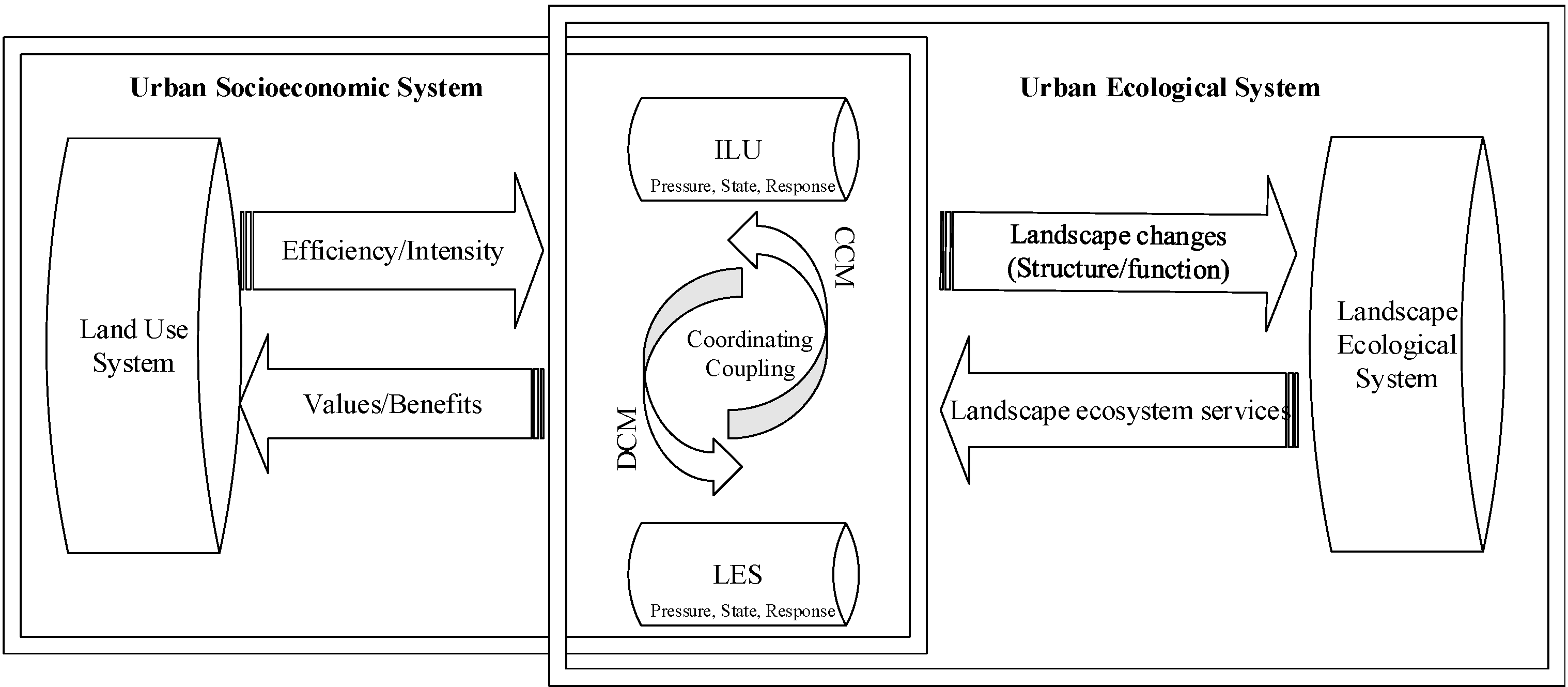
2.3.2.1. The Coupling Coordination Model
2.3.2.2. The Dynamic Coupling Model

- Mode I: Coordinated development. The value of ranges from 0° to 90°, VA and VB are both in the positive direction, and the two subsystems are under synergetic effect. In such mode, the ILU system collaborates with the LES system, land is in an intensive use trend, the security level is increasing, and the city is under sustainable development.
- Mode II: Restrained degeneration. The value of ranges from −180° to −90°, VA and VB are both in the negative direction, and the two subsystems are under a synergetic effect. However, the ILU system and LES system restrain each other. Land is under extensive use and damages the LES level; LES is unsafe and brings negative effects on the ILU system.
- Mode III: Extreme parasitism. The value of ranges from 90° to 180°, VA is in the positive direction, while VB is in the negative, and the two subsystems are under antagonistic effects. In such mode, land is under intensive use at the cost of decreasing LES; the urban landscape ecosystem would be degenerated and bring adverse effects on the urban socioeconomic system.
- Mode IV: Original symbiosis. The value of ranges from 0° to −90°, VA is in the negative direction, while VB is in the positive, and the two subsystems are under antagonistic effect. Since human activities are in low frequency, the land use system and landscape ecosystem are in their original status. Land is under extensive use without much anthropic development, while LES is at a low level and increasing naturally.
| Effect | Mode | Direction(VA,VB) | Angle degree | Radian |
|---|---|---|---|---|
| Synergetic | I: Coordinated development | (+, +) | 0° < α < 90° | (0, 1.57) |
| II: Restrained degeneration | (−, −) | 90° < α < 180° | (1.57, 3.14) | |
| Antagonistic | III: Extreme parasitism | (+, −) | −180° < α < −90° | (−3.14, −1.57) |
| IV: Original symbiosis | (−, +) | −90° < α < 0° | (−1.57, 0) |
3. Results and Discussion
3.1. Changes in the ILU and LES Systems
3.1.1. Results of ILU and LES
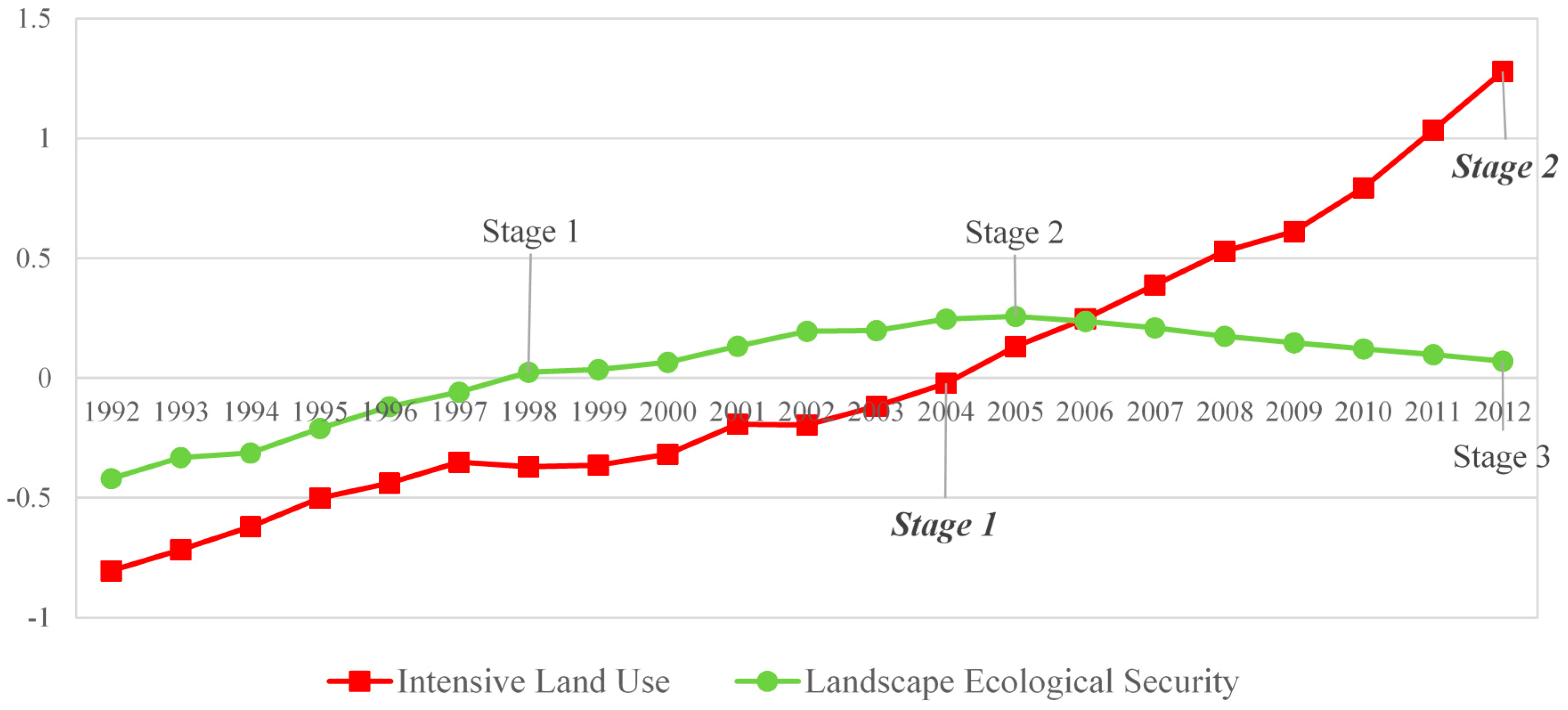
3.1.2. Analysis of ILU and LES Changes
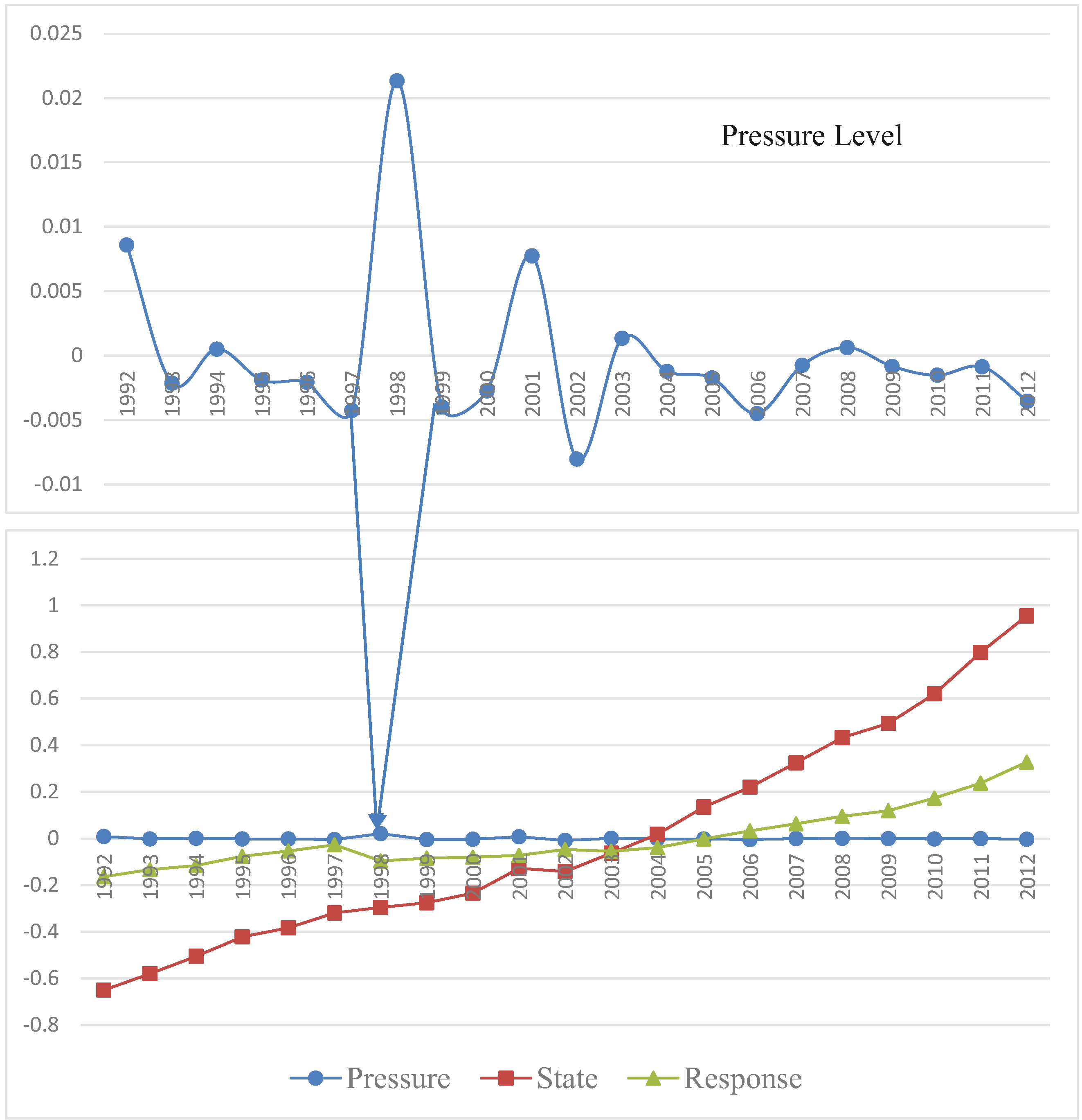
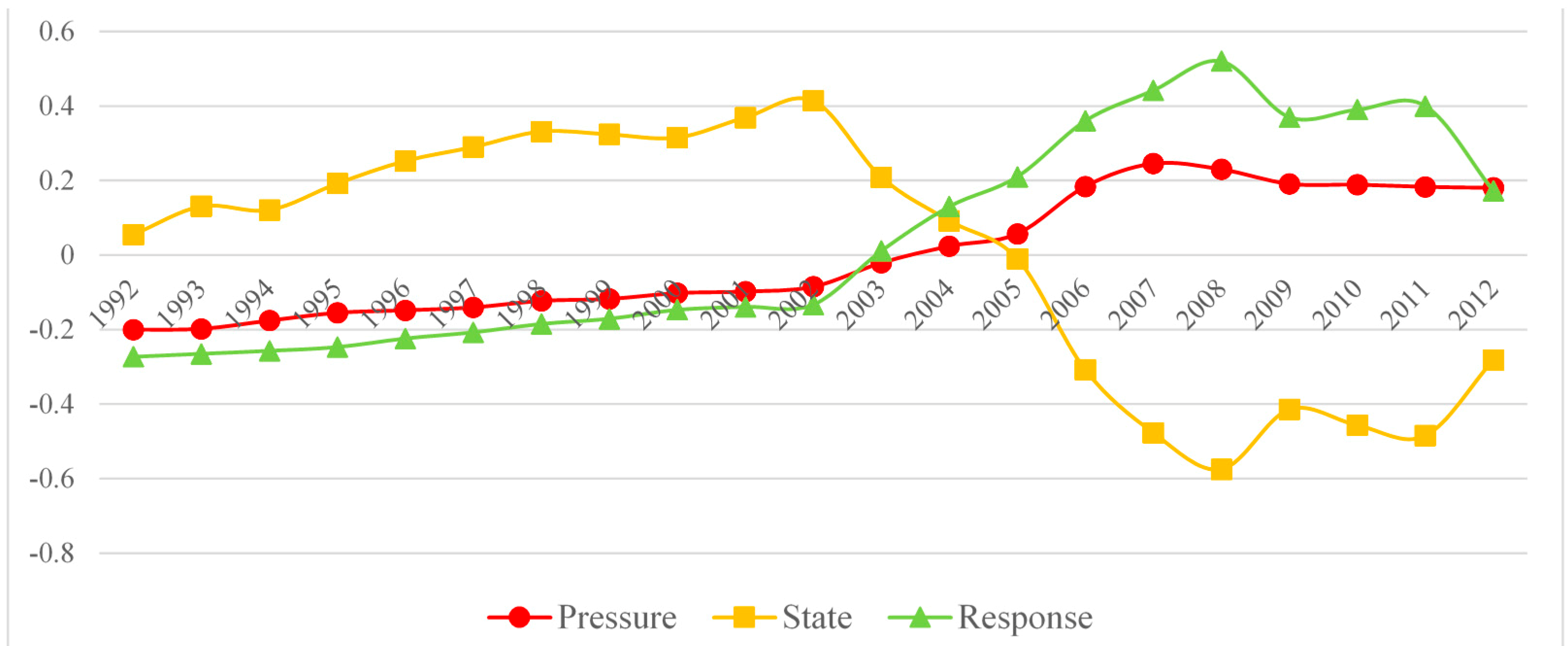
3.2. The Coupling Relationship between ILU and LES
3.2.1. Results of CCM and DCM within the ILU and LES Integrated System
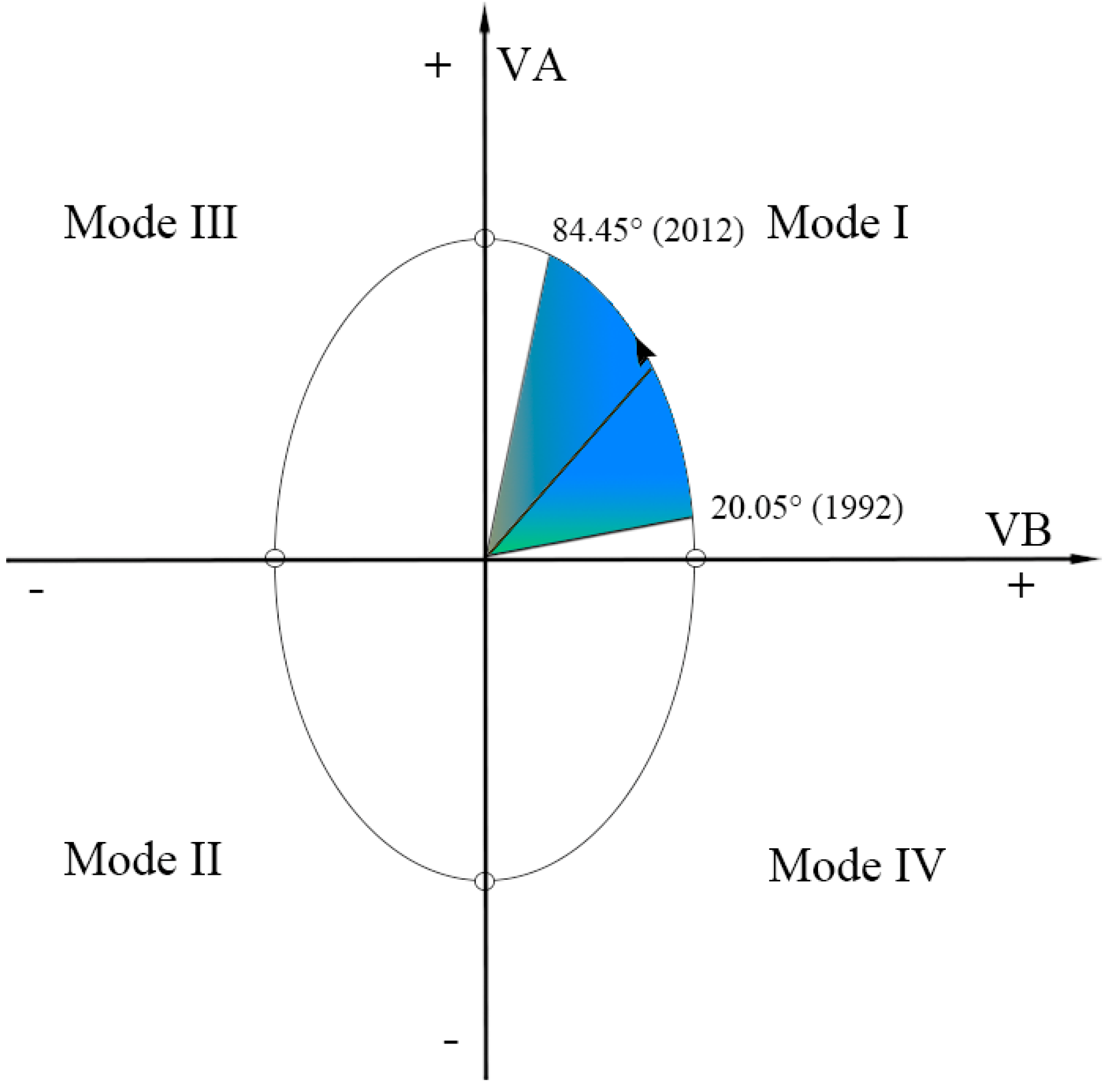
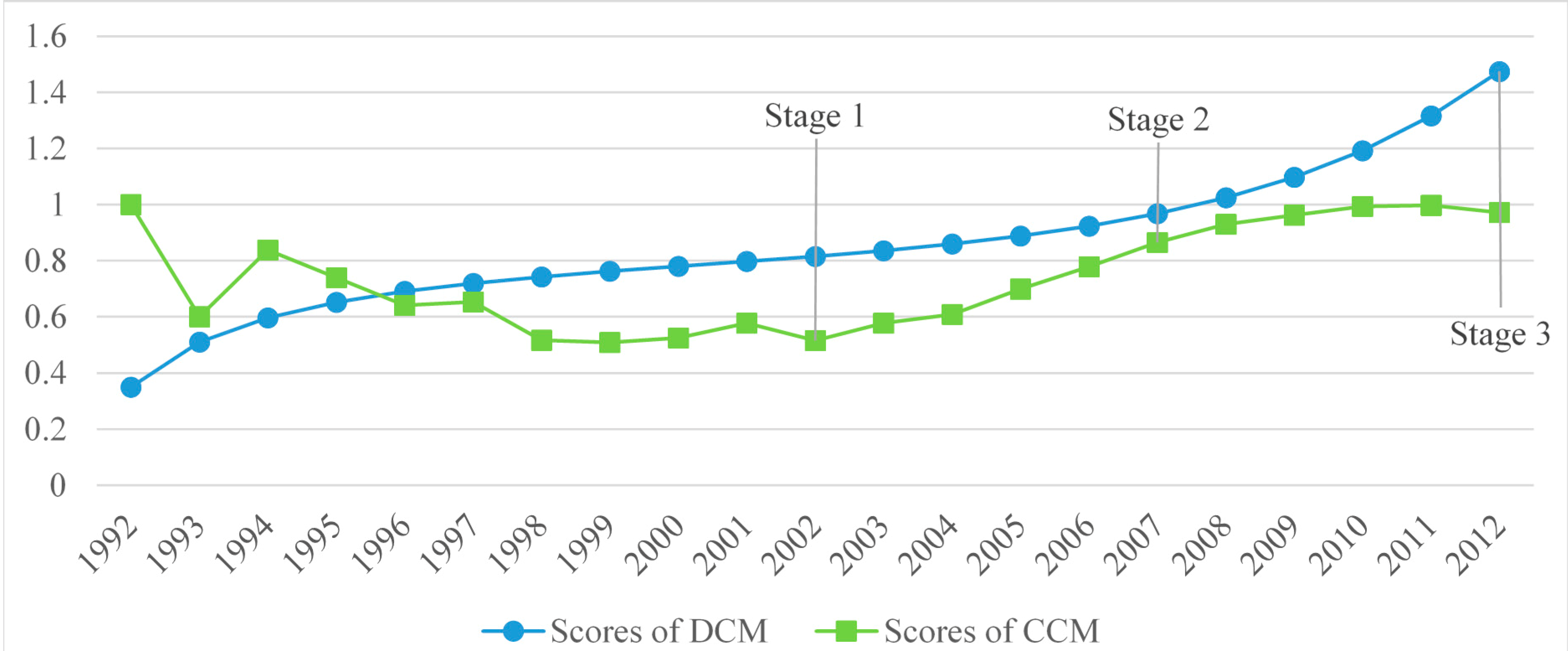
3.2.2. Discussion of the Coupling Relationship of the Integrated ILU and LES System
3.3. Methodological Discussion
3.4. Implications for Urban Sustainable Development
4. Conclusions
Acknowledgments
Author Contributions
Conflicts of Interest
References
- Boserup, E. Population and Technological Change: A Study of Long-Term Trends; University of Chicago Press: Chicago, IL, USA, 1981; p. 255. [Google Scholar]
- United Nations. World Urbanization Prospects: The 2014 Revision; Highlights (ST/ESA/SER.A/352); United Nations: New York, NY, USA, 2014; Volume 1. [Google Scholar]
- Haase, D.; Frantzeskaki, N.; Elmqvist, T. Ecosystem Services in Urban Landscapes: Practical Applications and Governance Implications. Ambio 2014, 43, 407–412. [Google Scholar] [CrossRef] [PubMed]
- Antrop, M. Landscape change and the urbanization process in Europe. Landsc. Urban Plan. 2004, 67, 9–26. [Google Scholar] [CrossRef]
- Haase, D.; Kabisch, N.; Haase, A. Endless urban growth? On the mismatch of population, household and urban land area growth and its effects on the urban debate. PLoS One 2013, 8, e66531. [Google Scholar] [CrossRef] [PubMed]
- Rowe, J.S.; Sheard, J. Ecological land classification: A survey approach. Environ. Manag. 1981, 5, 451–464. [Google Scholar] [CrossRef]
- Rowe, J.S. The ecosystem approach to forestland management. For. Chron. 1992, 68, 222–224. [Google Scholar] [CrossRef]
- Rowe, J.S. The level-of-integration concept and ecology. Ecology 1961, 42, 420–427. [Google Scholar] [CrossRef]
- De Groot, R.S.; Alkemade, R.; Braat, L.; Hein, L.; Willemen, L. Challenges in integrating the concept of ecosystem services and values in landscape planning, management and decision making. Ecol. Complex. 2010, 7, 260–272. [Google Scholar] [CrossRef]
- TEEB-The Economics of Ecosystems and Biodiversity. TEEB Manual for Cities: Ecosystem Services in Urban Management. Available online: http://www.teebweb.org/publication/teeb-manual-for-cities-ecosystem-services-in-urban-management (accessed on 18 September 2014).
- Burkhard, B.; Petrosillo, I.; Costanza, R. Ecosystem services—Bridging ecology, economy and social sciences. Ecol. Complex. 2010, 7, 257–259. [Google Scholar] [CrossRef]
- Millennium Ecosystem Assessment. In Ecosystems and Human Well-being: Synthesis; Island Press: Washington, DC, USA, 2005.
- Hassan, R.M.; Scholes, R.; Ash, N. Ecosystems and Human Well-Being: Current State and Trends: Findings of the Condition and Trends Working Group; Island Press: Washington, DC, USA, 2005; Volume 1, p. 1. [Google Scholar]
- Elmqvist, T.; Fragkias, M.; Goodness, J.; Güneralp, B.; Marcotullio, P.J.; McDonald, R.I.; Parnell, S.; Schewenius, M.; Sendstad, M.; Seto, K.C. Urbanization, Biodiversity and Ecosystem Services: Challenges and Opportunities; Springer: Berlin, Germany, 2013. [Google Scholar]
- Foley, J.A.; DeFries, R.; Asner, G.P.; Barford, C.; Bonan, G.; Carpenter, S.R.; Chapin, F.S.; Coe, M.T.; Daily, G.C.; Gibbs, H.K. Global consequences of land use. Science 2005, 309, 570–574. [Google Scholar] [CrossRef] [PubMed]
- Scalenghe, R.; Marsan, F.A. The anthropogenic sealing of soils in urban areas. Landsc. Urban Plan. 2009, 90, 1–10. [Google Scholar] [CrossRef]
- Mitchell, R.; Popham, F. Effect of exposure to natural environment on health inequalities: An observational population study. Lancet 2008, 372, 1655–1660. [Google Scholar] [CrossRef] [PubMed]
- Tzoulas, K.; Korpela, K.; Venn, S.; Yli-Pelkonen, V.; Kaźmierczak, A.; Niemela, J.; James, P. Promoting ecosystem and human health in urban areas using Green Infrastructure: A literature review. Landsc. Urban Plan. 2007, 81, 167–178. [Google Scholar] [CrossRef]
- Zhou, K.; Liu, Y.; Tan, R.; Song, Y. Urban dynamics, landscape ecological security, and policy implications: A case study from the Wuhan area of central China. Cities 2014, 41, 141–153. [Google Scholar] [CrossRef]
- Gabriel, S.A.; Faria, J.A.; Moglen, G.E. A multiobjective optimization approach to smart growth in land development. Socio-Econ. Plan. Sci. 2006, 40, 212–248. [Google Scholar] [CrossRef]
- Miller, J.S.; Hoel, L.A. The “smart growth” debate: Best practices for urban transportation planning. Socio-Econ. Plan. Sci. 2002, 36, 1–24. [Google Scholar] [CrossRef]
- Chen, H.; Jia, B.; Lau, S. Sustainable urban form for Chinese compact cities: Challenges of a rapid urbanized economy. Habitat Int. 2008, 32, 28–40. [Google Scholar] [CrossRef]
- Howley, P. Attitudes towards compact city living: Towards a greater understanding of residential behaviour. Land Use Policy 2009, 26, 792–798. [Google Scholar] [CrossRef]
- Lau, S.; Giridharan, R.; Ganesan, S. Multiple and intensive land use: Case studies in Hong Kong. Habitat Int. 2005, 29, 527–546. [Google Scholar] [CrossRef]
- Mander, Ü.; Helming, K.; Wiggering, H. Multifunctional Land Use: Meeting Future Demands for Landscape Goods and Services; Springer: Berlin, Germany, 2007; pp. 1–13. [Google Scholar]
- Slee, B. Social indicators of multifunctional rural land use: The case of forestry in the UK. Agric. Ecosyst. Environ. 2007, 120, 31–40. [Google Scholar] [CrossRef]
- Wiggering, H.; Dalchow, C.; Glemnitz, M.; Helming, K.; Müller, K.; Schultz, A.; Stachow, U.; Zander, P. Indicators for multifunctional land use—Linking socio-economic requirements with landscape potentials. Ecol. Indic. 2006, 6, 238–249. [Google Scholar] [CrossRef]
- Zhao, X.F.; Huang, X.J.; Chen, Y.; Chen, Z.G. Research Progress in Urban Land Intensive Use. J. Nat. Resour. 2010, 11, 1979–1996. [Google Scholar]
- Butler, A.; Åkerskog, A. Awareness-raising of landscape in practice. An analysis of Landscape Character Assessments in England. Land Use Policy 2014, 36, 441–449. [Google Scholar] [CrossRef]
- Pickett, S.T.; Cadenasso, M.L.; Grove, J.M. Resilient cities: Meaning, models, and metaphor for integrating the ecological, socio-economic, and planning realms. Landsc. Urban Plan. 2004, 69, 369–384. [Google Scholar] [CrossRef]
- Haase, D.; Larondelle, N.; Andersson, E.; Artmann, M.; Borgström, S.; Breuste, J.; Gren, Å.; Gomez-Baggethun, E.; Hamstead, Z.; Hansen, R.; et al. A Quantitative Review of Urban Ecosystem Service Assessments: Concepts, Models, and Implementation. Ambio 2014, 43, 413–433. [Google Scholar] [CrossRef] [PubMed]
- Carlson, T.N.; Traci Arthur, S. The impact of land use—Land cover changes due to urbanization on surface microclimate and hydrology: A satellite perspective. Glob. Planet Chang. 2000, 25, 49–65. [Google Scholar] [CrossRef]
- Wu, K.; Ye, X.; Qi, Z.; Zhang, H. Impacts of land use/land cover change and socioeconomic development on regional ecosystem services: The case of fast-growing Hangzhou metropolitan area, China. Cities 2013, 31, 276–284. [Google Scholar] [CrossRef]
- Su, S.; Xiao, R.; Jiang, Z.; Zhang, Y. Characterizing landscape pattern and ecosystem service value changes for urbanization impacts at an eco-regional scale. Appl. Geogr. 2012, 34, 295–305. [Google Scholar] [CrossRef]
- Hodson, M.; Marvin, S. “Urban ecological security”: A new urban paradigm? Int. J. Urban Reg. Res. 2009, 33, 193–215. [Google Scholar] [CrossRef]
- Du, P.; Xia, J.; Du, Q.; Luo, Y.; Tan, K. Evaluation of the spatio-temporal pattern of urban ecological security using remote sensing and GIS. Int. J. Remote Sens. 2012, 34, 848–863. [Google Scholar] [CrossRef]
- Li, X.; Tian, M.; Wang, H.; Wang, H.; Yu, J. Development of an ecological security evaluation method based on the ecological footprint and application to a typical steppe region in China. Ecol. Indic. 2014, 39, 153–159. [Google Scholar] [CrossRef]
- Wu, C.F.; Lu, Z.W.; Yang, Z.R.; Zheng, J.E.; Feng, K. Quantitative Study of Dynamic Relationship between Urbanization and Construction Land Expansion in China. China Land Sci. 2009, 2, 18–23. [Google Scholar]
- Riitters, K.H.; Wickham, J.D.; Wade, T.G. An indicator of forest dynamics using a shifting landscape mosaic. Ecol. Indic. 2009, 9, 107–117. [Google Scholar] [CrossRef]
- Huang, J.; Wang, R.; Zhang, H. Analysis of patterns and ecological security trend of modern oasis landscapes in Xinjiang, China. Environ. Monit. Assess. 2007, 134, 411–419. [Google Scholar] [CrossRef] [PubMed]
- Li, Y.; Sun, X.; Zhu, X.; Cao, H. An early warning method of landscape ecological security in rapid urbanizing coastal areas and its application in Xiamen, China. Ecol. Model. 2010, 221, 2251–2260. [Google Scholar] [CrossRef]
- Su, S.; Jiang, Z.; Zhang, Q.; Zhang, Y. Transformation of agricultural landscapes under rapid urbanization: A threat to sustainability in Hang-Jia-Hu region, China. Appl. Geogr. 2011, 31, 439–449. [Google Scholar] [CrossRef]
- Hammond, A.L.; World, R.I. Environmental Indicators: A Systematic Approach to Measuring and Reporting on Environmental Policy Performance in the Context of Sustainable Development; World Resources Institute: Washington, DC, USA, 1995. [Google Scholar]
- Kandziora, M.; Burkhard, B.; Müller, F. Interactions of ecosystem properties, ecosystem integrity and ecosystem service indicators—A theoretical matrix exercise. Ecol. Indic. 2013, 28, 54–78. [Google Scholar] [CrossRef]
- Feld, C.K.; Sousa, J.P.; da Silva, P.M.; Dawson, T.P. Indicators for biodiversity and ecosystem services: Towards an improved framework for ecosystems assessment. Biodivers. Conserv. 2010, 19, 2895–2919. [Google Scholar] [CrossRef]
- Pinto, R.; de Jonge, V.N.; Neto, J.M.; Domingos, T.; Marques, J.C.; Patrício, J. Towards a DPSIR driven integration of ecological value, water uses and ecosystem services for estuarine systems. Ocean Coast. Manag. 2013, 72, 64–79. [Google Scholar] [CrossRef]
- Huang, H.; Kuo, J.; Lo, S. Review of PSR framework and development of a DPSIR model to assess greenhouse effect in Taiwan. Environ. Monit. Assess. 2011, 177, 623–635. [Google Scholar] [CrossRef] [PubMed]
- Niemeijer, D.; de Groot, R.S. A conceptual framework for selecting environmental indicator sets. Ecol. Indic. 2008, 8, 14–25. [Google Scholar] [CrossRef]
- Meng, Y.; Zhang, F.; An, P.; Dong, M.; Wang, Z.; Zhao, T. Industrial land-use efficiency and planning in Shunyi, Beijing. Landsc. Urban Plan. 2008, 85, 40–48. [Google Scholar] [CrossRef]
- Herold, M.; Scepan, J.; Clarke, K.C. The use of remote sensing and landscape metrics to describe structures and changes in urban land uses. Environ. Plan. A 2002, 34, 1443–1458. [Google Scholar] [CrossRef]
- Jenerette, G.D.; Wu, J. Analysis and simulation of land-use change in the central Arizona–Phoenix region, USA. Landsc. Ecol. 2001, 16, 611–626. [Google Scholar] [CrossRef]
- Luck, M.; Wu, J. A gradient analysis of urban landscape pattern: A case study from the Phoenix metropolitan region, Arizona, USA. Landsc. Ecol. 2002, 17, 327–339. [Google Scholar] [CrossRef]
- Weng, Y. Spatiotemporal changes of landscape pattern in response to urbanization. Landsc. Urban Plan. 2007, 81, 341–353. [Google Scholar] [CrossRef]
- Xu, J.; Grumbine, R.E.; Beckschäfer, P. Landscape transformation through the use of ecological and socioeconomic indicators in Xishuangbanna, Southwest China, Mekong Region. Ecol. Indic. 2014, 36, 749–756. [Google Scholar] [CrossRef]
- Wang, Y. Study on Indictors for the Assessment of Land Saving and Intensive Use. China Land Sci. 2006, 20, 24–31. [Google Scholar]
- Yang, D.; An, X. Colligation evaluation of Xi’an urban land intensive use. Econ. Geogr. 2007, 22, 111–115. [Google Scholar]
- Tan, M.; Li, X.; Xie, H.; Lu, C. Urban land expansion and arable land loss in China—A case study of Beijing-Tianjin-Hebei region. Land Use Policy 2005, 22, 187–196. [Google Scholar] [CrossRef]
- Hangzhou Municipal Statistic Bureau. Available online: http://www.hzstats.gov.cn/web/more2.aspx?id=EuvfD175mjE=&name=vdpsN636PcaolV18yOEw4A== (accessed on 18 September 2014).
- Costanza, R.; D’Arge, R.; Groot, R.D.; Farber, S.; Grasso, M.; Hannon, B.; Limburg, K.; Naeem, S.; O’Neill, R.V.; Paruelo, J. The value of the world’s ecosystem services and natural capital. Nature 1997, 387, 253–260. [Google Scholar] [CrossRef]
- Kreuter, U.P.; Harris, H.G.; Matlock, M.D.; Lacey, R.E. Change in ecosystem service values in the San Antonio area, Texas. Ecol. Econ. 2001, 39, 333–346. [Google Scholar] [CrossRef]
- Xie, G.D.; Lu, C.X.; Leng, Y.F.; Zheng, D.; Li, S.C. Ecological assets valuation of the Tibetan Plateau. J. Nat. Resour. 2003, 2, 189–196. [Google Scholar]
- Fang, M.; Wu, C.F.; Shen, X.Q.; Lv, T.G. Evolution of Ecosystem Service Value in Hangzhou. Areal Res. Dev. 2014, 33, 153–158. [Google Scholar]
- Linstone, H.A.; Turoff, M. The Delphi Method: Techniques and Applications; Addison-Wesley Reading MA: Boston, MA, USA, 1975; Volume 29. [Google Scholar]
- Zou, Z.; Yun, Y.; Sun, J. Entropy method for determination of weight of evaluating indicators in fuzzy synthetic evaluation for water quality assessment. J. Environ. Sci. 2006, 18, 1020–1023. [Google Scholar] [CrossRef]
- Shannon, C.E. A mathematical theory of communication. ACM Sigmobile Mob. Comput. Commun. Rev. 2001, 5, 3–55. [Google Scholar] [CrossRef]
- Larsen, T.A.; Gujer, W. The concept of sustainable Urban Water Management. Water Sci. Technol. 1997, 35, 3–10. [Google Scholar] [CrossRef]
- Antrop, M. Landscape change: Plan or chaos? Landsc. Urban Plan. 1998, 41, 155–161. [Google Scholar] [CrossRef]
- Balocco, C.; Grazzini, G. Thermodynamic parameters for energy sustainability of urban areas. Sol. Energy 2000, 69, 351–356. [Google Scholar] [CrossRef]
- Herrmann-Pillath, C.; Kirchert, D.; Pan, J. Disparities in Chinese economic development: approaches on different levels of aggregation. Econ. Syst. 2002, 26, 31–54. [Google Scholar] [CrossRef]
- Shemshadi, A.; Shirazi, H.; Toreihi, M.; Tarokh, M.J. A fuzzy VIKOR method for supplier selection based on entropy measure for objective weighting. Expert Syst. Appl. 2011, 38, 12160–12167. [Google Scholar] [CrossRef]
- Song, H.M.; Hou, H.P.; Zhang, S.L.; Ding, Z.Y.; Huang, J.H. Research on Evaluation of Urban Land Intensive Utilization—A Case Study in Xuzhou City. Resour. Dev. Market 2007, 23, 116–118. [Google Scholar]
- Li, Z.; Yongming, Z.; Meichen, F.; Pengtao, Z.; Yingui, C. Comparative study on intensive use of rural residential land based on principal component analysis and entropy method. Trans. Chin. Soc. Agric. Eng. 2012, 28, 235–242. [Google Scholar]
- Carver, S.J. Integrating multi-criteria evaluation with geographical information systems. Int. J. Geogr. Inf. Syst. 1991, 5, 321–339. [Google Scholar] [CrossRef]
- Sun, X.; Zhu, X.D.; Li, Y.F. Landscape ecological security assessment in rapidly urbanizing bay-area: A case study of Xiamen City, China. Acta Ecol. Sin. 2008, 28, 3563–3573. [Google Scholar]
- Hangzhou Bureau of Land and Resources. Available online: http://www.hzgtj.gov.cn:83/page/guihua/page.asp?id=858 (accessed on 18 September 2014).
- Vapnik, V.N.; Vapnik, V. Statistical Learning Theory; Wiley: New York, NY, USA, 1998; Volume 2. [Google Scholar]
- Hangzhou Municipal Government. Available online: http://www.hangzhou.gov.cn/main/zfxxgk/glgh/jhzj/index.shtml (accessed on 18 September 2014).
- Hangzhou Environmental Protection Bureau. Available online: http://www.hzepb.gov.cn/zwxx/gkml/zxgk/index_1.htm (accessed on 18 September 2014).
- Ruehli, A.E. Equivalent circuit models for three-dimensional multiconductor systems. IEEE Trans. Microw. Theory Tech. 1974, 22, 216–221. [Google Scholar] [CrossRef]
- Huang, J.C.; Fang, C.L. Analysis of coupling mechanism and rules between urbanization and eco-environment. Geogr. Res. 2003, 22, 211–220. [Google Scholar]
- Liu, Y.B.; Li, R.D.; Song, X.F. Analysis of Coupling Degrees of Urbanization and Ecological Environment in China. J. Nat. Resour. 2005, 1, 105–112. [Google Scholar]
- Liao, C.B. Quantitative judgment and classification system for coordinated development of environment and economy- A Case Study of the City Group in the Pearl River Delta. Trop. Geogr. 1999, 19, 171–177. [Google Scholar]
- Haken, H.; Graham, R. Synergetik-Die Lehre vom Zusammenwirken. Umschau Wissenschaft und Technik 1971, 6, 191–195. [Google Scholar]
- Lyapunov, A.M. The general problem of the stability of motion. Int. J. Control 1992, 55, 531–534. [Google Scholar] [CrossRef]
- Bertalanffy, L.V. General Systems Theory: Foundations, Development, Applications, Revised Edition; George Braziller: New York, NY, USA, 1976. [Google Scholar]
- Yue, W.; Liu, Y.; Fan, P. Measuring urban sprawl and its drivers in large Chinese cities: The case of Hangzhou. Land Use Policy 2013, 31, 358–370. [Google Scholar] [CrossRef]
- Li, B.J.; Wang, W.M. Coupling relationship between regional land use and eco-environment. Arid Land Geogr. 2008, 1, 142–148. [Google Scholar]
- Walker, B.; Holling, C.S.; Carpenter, S.R.; Kinzig, A. Resilience, adaptability and transformability in social—Ecological systems. Ecol. Soc. 2004, 9. Article 5. [Google Scholar]
- Pickett, S.T.A.; Cadenasso, M.L.; Grove, J.M.; Nilon, C.H.; Pouyat, R.V.; Zipperer, W.C.Ô.C. Urban Ecological Systems: Linking Terrestrial Ecological, Physical, and Socioeconomic Components of Metropolitan Areas 1. Ann. Rev. Ecol. Syst. 2001, 32, 127–157. [Google Scholar] [CrossRef]
- Leitão, A.B.; Ahern, J. Applying landscape ecological concepts and metrics in sustainable landscape planning. Landsc. Urban Plan. 2002, 59, 65–93. [Google Scholar] [CrossRef]
- Zhang, J.; Fu, M.; Zhang, Z.; Tao, J.; Fu, W. A trade-off approach of optimal land allocation between socio-economic development and ecological stability. Ecol. Model. 2014, 272, 175–187. [Google Scholar] [CrossRef]
- Klosterman, R.E. The what if? Collaborative planning support system. Environ. Plan. B 1999, 26, 393–408. [Google Scholar] [CrossRef]
- Pham, H.M.; Yamaguchi, Y.; Bui, T.Q. A case study on the relation between city planning and urban growth using remote sensing and spatial metrics. Landsc. Urban Plan. 2011, 100, 223–230. [Google Scholar] [CrossRef]
- Wu, Y.Z.; Wu, C.F.; Li, B.; Luo, W.B. Research on spatial-temporal evolution and its mechanisms for urban planning control performance: A case study on five master plans of Beijing during 1958–2004. City Plan. Rev. 2013, 7, 33–41. [Google Scholar]
- Bengston, D.N.; Fletcher, J.O.; Nelson, K.C. Public policies for managing urban growth and protecting open space: Policy instruments and lessons learned in the United States. Landsc. Urban Plan. 2004, 69, 271–286. [Google Scholar] [CrossRef]
© 2015 by the authors; licensee MDPI, Basel, Switzerland. This article is an open access article distributed under the terms and conditions of the Creative Commons Attribution license (http://creativecommons.org/licenses/by/4.0/).
Share and Cite
Cen, X.; Wu, C.; Xing, X.; Fang, M.; Garang, Z.; Wu, Y. Coupling Intensive Land Use and Landscape Ecological Security for Urban Sustainability: An Integrated Socioeconomic Data and Spatial Metrics Analysis in Hangzhou City. Sustainability 2015, 7, 1459-1482. https://doi.org/10.3390/su7021459
Cen X, Wu C, Xing X, Fang M, Garang Z, Wu Y. Coupling Intensive Land Use and Landscape Ecological Security for Urban Sustainability: An Integrated Socioeconomic Data and Spatial Metrics Analysis in Hangzhou City. Sustainability. 2015; 7(2):1459-1482. https://doi.org/10.3390/su7021459
Chicago/Turabian StyleCen, Xiaoteng, Cifang Wu, Xiaoshi Xing, Ming Fang, Zhuoma Garang, and Yizhou Wu. 2015. "Coupling Intensive Land Use and Landscape Ecological Security for Urban Sustainability: An Integrated Socioeconomic Data and Spatial Metrics Analysis in Hangzhou City" Sustainability 7, no. 2: 1459-1482. https://doi.org/10.3390/su7021459
APA StyleCen, X., Wu, C., Xing, X., Fang, M., Garang, Z., & Wu, Y. (2015). Coupling Intensive Land Use and Landscape Ecological Security for Urban Sustainability: An Integrated Socioeconomic Data and Spatial Metrics Analysis in Hangzhou City. Sustainability, 7(2), 1459-1482. https://doi.org/10.3390/su7021459





